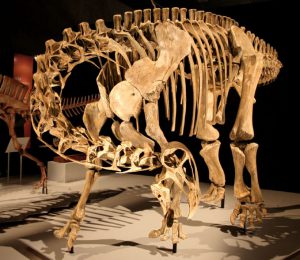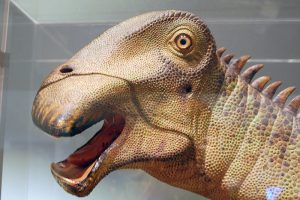by Lilia Leung
Dinosaur fossils have been discovered on every continent on earth (though of course when dinosaurs roamed, there was still only one supercontinent, Pangaea). There have been numerous fossils found in Africa, including some in Niger. One of the most well-known fossils found was the Nigersaurus, named after the country where it was discovered.
The first Nigersaurus fossils were found around 50 years ago in the Erlhaz Formation, located in Niger’s Ténéré Desert. They were discovered in a paleontological expedition led by French paleontologist Philippe Taquet. It was the first expedition of its kind in Niger, and it proved to be very fruitful.

Upon studying the fossils, the Nigersaurus was determined to have lived in the Early Cretaceous period, more than 100 million years ago. The Nigersaurus was a rebbachisaurid sauropod (which means it was a long-necked, long-tailed, small-headed dinosaur that walked on four legs and belonged to a family of fossils found in South America, Africa, and Europe). The Nigersaurus was estimated to weigh four tons (about the average weight of an adult elephant) and around nine meters long, which is short for a sauropod. It had a wide, rounded muzzle with 500 teeth that were replaced at an astonishing rate of every 14 days.
The blunted muzzle of the Nigersaurus provides a clue on what it ate during the Cretaceous period. The Nigersaurus is often referred to as the Mesozoic Cow since paleontologists believe it often grazed with its head close to the ground. In fact, the Nigersaurus was a megaherbivore, whose diet likely consisted of soft plants, such as ferns, horsetails and flowering plants (grass had not even evolved at that time, and would not have evolved until the Late Cretaceous period). This suggests that back in the Early Cretaceous period, the vegetation of the Ténéré Desert at least included soft plants.

Plant fossils found in the region of the Sahara Desert showed the existence of cycads and conifers in the Cretaceous period (though they were unlikely to have been fodder for the Nigersaurus, as they were not at the appropriate height) in addition to ferns. From the evidence of various fossils, it was hypothesized that the Sahara region had greenery and fast river systems millions of years ago. In the same expedition, the fossils of the Lurdusaurus, the Ouranosaurus, and the Elrhazsaurus were also found in the Erlhaz Formation, and all of these dinosaurs were found to be herbivores as well. This further supports the hypothesis that the area had an abundance of greenery.
While the structure of a dinosaur skeleton provides information about the environment at the time it was alive, it doesn’t provide much information about the climate. Luckily, we’re able to rely on other types of evidence, such as plant fossils, sediments, and our knowledge of the dinosaurs’ diets to learn about the climate. Paleobotanic evidence shows the probability of episodic droughts and semi-arid climates, which would still allow flowering plants and other soft vegetation to prosper.
While it’s certainly interesting to learn what the earth and land used to be like millions of years ago and how it has changed, scientists also believe that gaining an understanding of the environment in the Cretaceous period can help inform our understanding of the process of global warming, which has a direct impact on life today, particularly in drought-prone countries like Niger where people now die not just from drinking contaminated water, but from dehydration as well.
To see all the dinosaur fossil discoveries that have occurred around the world, visit the Paleobiology Database.
Resources:
- Sereno, P. C., Wilson, J. A., Witmer, L. M., Whitlock, J. A., Maga, A., Ide, O., & Rowe, T. A. (2007). Structural extremes in a Cretaceous dinosaur. PLoS One, 2(11), e1230.
Russell, D. A., & Paesler, M. A. (2003). Environments of mid-Cretaceous Saharan dinosaurs. Cretaceous Research, 24(5), 569-588.


